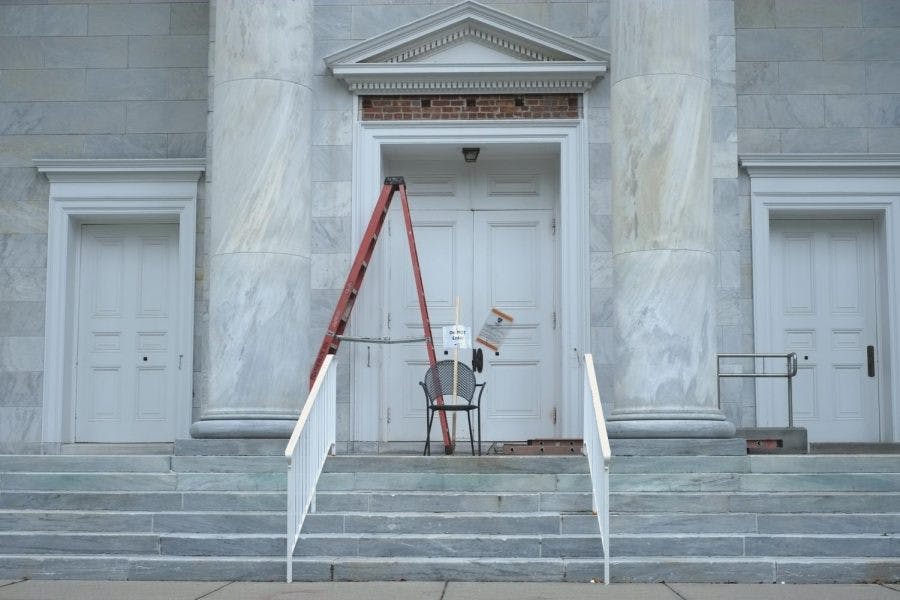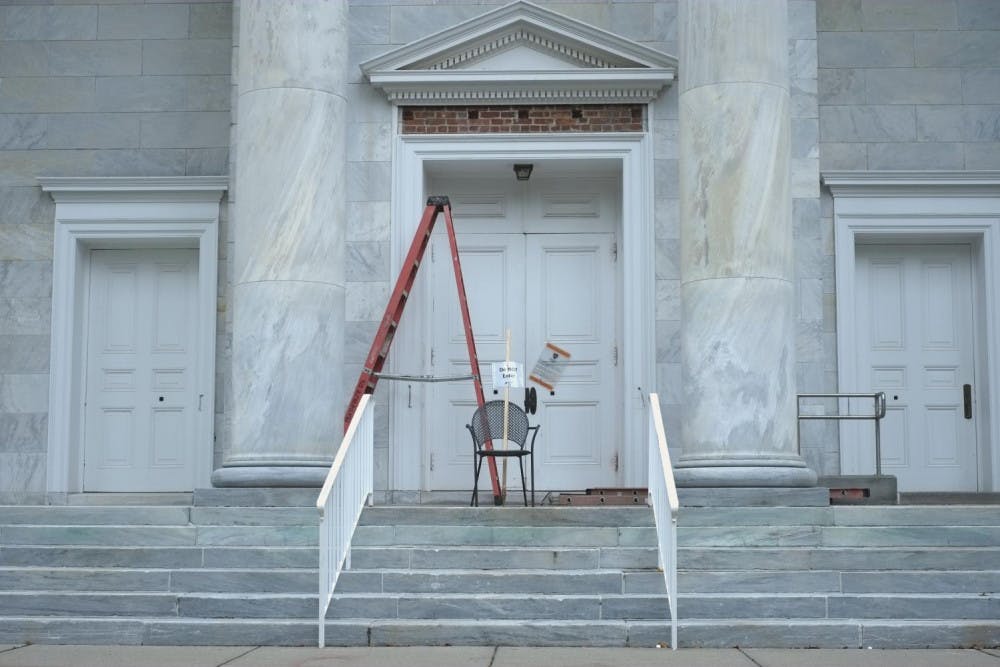
In the early morning of Monday, Sept. 27, the stone slab engraved with “Mead Memorial Chapel” was removed from its place atop the entrance of the chapel. A few hours later, college President Laurie Patton and Chair of the Board of Trustees George Lee sent an email to the community explaining that chapel would no longer bear the name John Mead, Vermont governor from 1910 to 1912 and Middlebury class of 1864, due to his role in promoting eugenics policies in the state that led to the involuntary sterilization of an estimated 250 people.
In 1914, Mead and his wife Mary Madelia Sherman donated $74,000, the equivalent of about $2 million in today’s money, for the creation of a new chapel. As the highest point on campus, the site of freshman convocation and a frequent symbol on college merchandise, the chapel has since become an iconic feature of Middlebury’s landscape and branding. It will now be referred to as “The Middlebury Chapel” or just “the chapel.”
Following unanimous decisions in the Vermont House and Senate in spring of 2021 to “sincerely apologize and express sorrow and regret” for the state’s eugenics campaign, a working group composed of members from the Senior Leadership Group chosen by Patton, as well as student, faculty and alumni representatives, began working in May 2021 to develop a recommendation for the Board of Trustees on the question of removing Mead’s name from the chapel.
The working group members included Provost Jeff Cason, Dean of Admissions Nicole Curvin, Chief Diversity Officer Miguel Fernandez, Vice President for Advancement Colleen Fitzpatrick, Vice President for Communications David Gibson, Alumni Association President Janine Hetherington ’95, Director and Curator of Special Collections Rebekah Irwin, Student Government Association President Roni Lezama ’22, Associate Professor of History Joyce Mao, Executive Vice President David Provost and General Counsel Hannah Ross, who acted as chair of the group.
The committee was gathered with the aim of including a variety of viewpoints. “Different members brought their own expertise and experience to these conversations,” Ross said.
Over the course of a month, the committee reviewed a comprehensive and varied group of materials largely put together by Irwin. The first group of documents were Vermont Public Records, mainly from 1911 to 1914 but including some published onward through the 1930s. One of the reports, submitted to the “Trustees of the Vermont State Hospital for the Insane,” explicitly named Mead as an advocate of eugenics. In the report, a hospital official wrote, “Governor Mead has an idea in view, which in my opinion, should be endorsed by legal enactment, for the sterilization of these degenerates.” The degenerates in question were identified as “dangerous imbeciles,” particularly females during the “procreative period.”
Other resources included the scholarship of independent historians Mercedes de Guardiola, Kevin Dann and Nancy Gallagher, an online archive called “Vermont Eugenics: A Documentary History,” Vermont newspapers from the early 20th century, college archival records, college Trustee minutes, correspondence between John Mead and Middlebury President John Thomas, College Advancement records and documents in the Records of the Office of the Governor at the State Historical Society in Middlesex, VT, according to Irwin.
Irwin further noted that the group considered experiences of other schools in similar situations, such as the efforts of the “Yale University Committee to Establish Principles on Renaming.” This document also guided the University of Vermont’s renaming of the Bailey Howe Library. Other schools that have grappled with the symbolism of building names, mascots and campus symbols include Bryn Mawr College, the University of Richmond, Princeton University and Georgetown University.
Of all the information available, particularly influential was the State Legislature’s background research, witnesses and documentation around Bill J.R.H.2. This Joint Resolution points directly to a 1912 bill put forward by Governor Mead, which was passed by the Vermont General Assembly but then vetoed by Governor Allen M. Fletcher due to constitutional concerns, that led “directly to Vermont state agencies and institutions adopting policies and procedures that carried out ‘the intent of the vetoed legislation and the beliefs of the eugenics movement,’” wrote Irwin in an email to The Campus. “The state legislature itself drew that painful line back to Mead’s proposed legislation,” she continued.
After a careful review of these materials, the group made its recommendation to remove Mead’s name in June 2021. The Board of Trustees made its decision unanimously by late August.
The email announcement stressed the working group’s concerted efforts to recognize the complexities involved in renaming: “We want to stress up front that this was a process involving deep reflection and discussion. No issue like this should be undertaken lightly or often,” it read.
For Lezama, this comprehensive process led to a clear conclusion. “People will praise academia for being a space to have young students deliberate hard topics, but as we actually consider the individual lives of the students that compose Middlebury, it’s also about providing equitable spaces for these students, especially BIPOC and low-income students, to thrive. There is no ‘maybe we should hear them out’ when it comes to a subject like eugenics that is terribly harmful and has very serious impacts on the well-being of students,” he said.
As the only student in the group, Lezama’s main goal was to ensure that the name change itself, though symbolic and powerful, is not the end of the college’s efforts to support students from historically marginalized communities. “This is about moving forward and actively educating ourselves on harm that is done to members of our community, past or present. With these actions, Middlebury has an opportunity to differentiate itself from the rest of academia by actively taking a stance against ideals that harm its students. A space representing eugenics has no place on our campus.”
However, not everyone in the Middlebury community shares Lezama’s conviction that the removal of Mead’s name was the proper choice. James Douglas ’72, a former governor of Vermont and executive in residence at the college, expressed a number of reasons he was unhappy with the decision. The first regarded the process itself: “I was shocked to see the lack of transparency. This was done by a secret committee. The [slab’s removal] was done under the cover of darkness. I don’t understand that mentality, when in other endeavors the college has been open and inclusive,” he said.
According to Ross, the early morning removal of the slab was due to the Facilities Department’s schedule, which begins its workday at 7 a.m.
Next, Douglas explained why he does not feel the removal of Mead’s name is a fair representation of Mead’s career. “I certainly don’t condone the study of or implementation of a eugenics program, but those were different times. There was a great deal of support for eugenics among people with distinguished careers, including Teddy Roosevelt, Margaret Sanger, W.E.B. Du Bois and Helen Keller. So, I think it’s unfair to apply a 21st century lens to another era in our history,” he said.
Douglas also noted that the removal announcement ignores many other positive aspects of Mead’s career, including his support for progressive child labor laws, his creation of a school of agriculture that is now Vermont Technical College, his doubling of highway funding and his efforts to reform campaign finance. “I really believe that someone’s legacy should be determined by the entirety of his or her life, not by comments that are later unfortunate. No one is perfect, especially with the hindsight of history,” Douglas said.
Taking issue with the college’s claim that the name removal does not amount to an erasure of history, Douglas replied, “Of course they are. One important element of history is that he gave the money, and his name has been on it for more than a century. I think it would be appropriate to return the money [for the chapel] and other money that he gave to the college.”
According to the administration, Mead’s financial gift to the college was not conditional upon his name being put on the building, so the college is not obligated to return the gift to the Mead family.
Lastly, Douglas was perplexed as to why the action was taken when the vast majority of students were likely unaware of Mead’s history and connection to eugenics. Nor does he believe the Vermont legislature’s formal apology necessitated the name removal. “I don’t think [the apology] leads to this cancellation of the legacy of the philanthropy of Governor Mead. The college has made a serious mistake,” he said.
Though there have been no previous calls for the removal of Mead’s name by Middlebury community members, Irwin noted that more and more colleges and universities across the country are beginning to engage in honest debates and conversations about what and who they choose to commemorate. “It’s about how those choices express our values,” she said.
Thinking of the broader implications of the decision, Douglas commented, “There is a growing attitude in academia of wokeness and political correctness. We all need to take a deep breath. A college campus is the kind of place we ought to be able to have these discussions, even uncomfortable decisions. This decision runs counter to the purpose of higher education.”
Reiterating the official announcement, Ross stated, “This is not about erasing history, but just the opposite — engaging with it so we can learn from it. Our educational mission is at the center of all these deliberations.”
The Educational Task Force is currently planning to work with a variety of departments and groups on campus to develop recommendations on how to acknowledge and educate about the decision to first honor a member of this community and then remove that honor, according to Ross. “Our educational efforts might include signage, architectural installations and public art – with the goal of encouraging constructive dialogue and debate around not only the issue of the chapel name but also its wider implications as a complex issue of our time,” she said.
As of now, there are no plans to actively enforce the new name or obligate employees to refrain from referring to the chapel as Mead Chapel, according to Ross. The Educational Task Force may consider a publicity campaign to promote a new name if one is chosen for the chapel, but such a campaign is not part of the administration’s current plans.

Ideal Dowling
Ideal Dowling '22 is an Editor at Large.
She previously served as a copy editor and Local section editor.
Dowling is majoring in Political Science and minoring in French and History. During the summer of 2021, she worked as a consultant for the startup accelerator Aegis Ventures and as a research assistant for Professor Stanley Sloan as he worked on his book "De-Trumping U.S. Foreign Policy: Can Biden Bring America Back?" In addition to her work at The Campus, Dowling is captain of Middlebury's women's squash team and an employee at the Middlebury College Museum of Art.
Comments




